Building a 6-Month Mental Wellness Plan With Renue


July 28, 2025
Embracing Renewal and Growth in Mental Health
Spring serves as a powerful metaphor for renewal and growth, offering an ideal backdrop for developing a comprehensive 6-month mental wellness plan with Renue. As daylight increases and nature blooms, individuals are encouraged to refresh their mindset, adopt healthier habits, and build resilience. This article explores how structured planning, organizational resources, and evidence-based strategies can foster long-term mental health improvements, ensuring a sustainable journey toward well-being.
Understanding the Foundation of a 6-Month Mental Wellness Plan
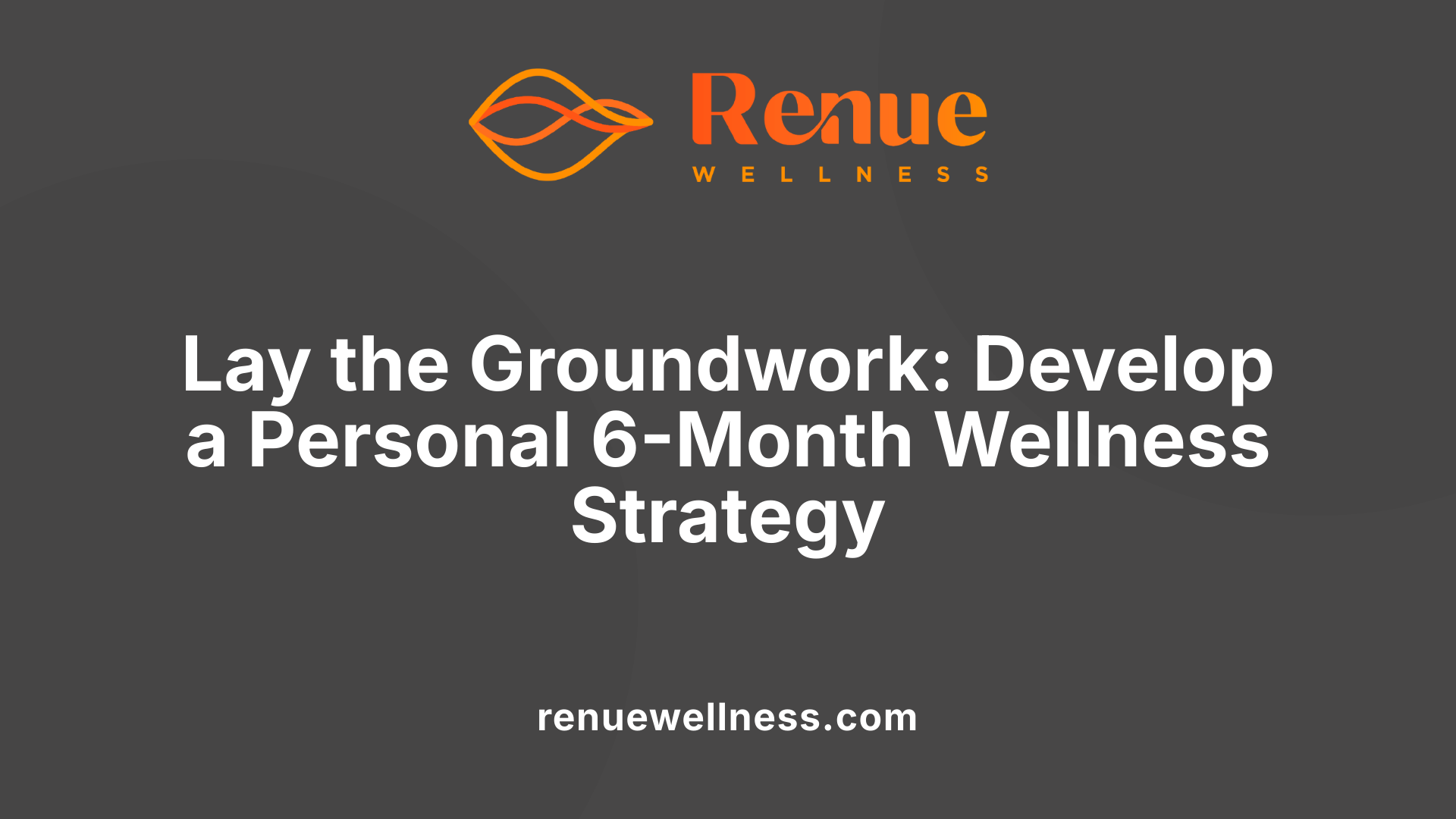
How can I develop a comprehensive mental wellness plan?
Creating a mental wellness plan that effectively supports your mental health over six months begins with a clear understanding of your current state. Start with self-assessment techniques by reflecting on your stress levels, emotional triggers, and coping strategies. This helps identify areas needing attention and guides goal setting.
Early planning is vital. Establishing a timeline with specific milestones allows for progress tracking and necessary adjustments. Incorporating activities that promote mental health, such as physical exercise, balanced nutrition, sufficient sleep, and mindfulness practices, can build a stable foundation.
When designing your goals, ensure they are both measurable and achievable. Using the SMART criteria—specific, measurable, attainable, relevant, and time-bound—helps create realistic targets that motivate continued effort.
Developing a detailed plan includes supporting relationships, learning new skills, and practicing gratitude or giving to others to foster purpose and social connection. Consider creating a personalized Wellness Action Plan (WAP), which outlines your strategies, recognizes warning signs, and suggests workplace or lifestyle adjustments.
Review this plan regularly, every few months, to evaluate progress and modify goals as circumstances evolve. If symptoms persist or intensify, seeking professional help from mental health providers is crucial.
Incorporating these steps ensures your mental wellness plan remains flexible, personalized, and effective, providing ongoing support through your journey towards better mental health.
Incorporating Nature and Outdoor Activities to Boost Mental Health
What are the benefits of sunlight and outdoor exposure?
Spring offers a natural opportunity to boost mental well-being through increased daylight exposure. Sunlight stimulates serotonin production in the brain, which is associated with improved mood and decreased symptoms of seasonal affective disorder (SAD). Spending at least 20 minutes outdoors daily, especially in the morning, can help regulate sleep-wake cycles and foster a sense of calm and happiness.
What activities like walking, gardening, and outdoor yoga can do for mental health?
Engaging in outdoor activities such as walking, gardening, or outdoor yoga not only provides physical exercise but also promotes mental relaxation. These activities help reduce stress by encouraging mindfulness and physical presence in natural surroundings. Walking barefoot on grass, sitting under trees, or practicing yoga in the park can deepen your connection with nature, which has been shown to improve cognitive function and lift overall mood.
How does connection with nature reduce stress?
Nature-based activities foster a sense of peace and reduce mental clutter. Observing natural surroundings or participating in activities like sitting quietly under trees helps calm the mind. Such experiences can decrease cortisol levels, the stress hormone, and increase feelings of tranquility. Additionally, being in natural environments encourages mindfulness, helping individuals stay present and reduce anxiety.
| Activity | Mental Health Benefit | Examples of Activities |
|---|---|---|
| Sunlight Exposure | Boosts serotonin, improves mood, regulates sleep cycles | Morning walks, outdoor dining, gardening |
| Physical Outdoors | Reduces stress, promotes physical health, enhances cognitive clarity | Walking, outdoor yoga, running, cycling |
| Connection with Nature | Decreases cortisol, supports emotional resilience, fosters peace | Sitting under trees, barefoot walking, bird watching |
| Mindfulness Practices | Improves focus, reduces anxiety, encourages present-moment awareness | Meditation in parks, observing natural sounds |
What are strategies and tools for creating a long-term mental health improvement plan?
Building a sustainable mental health routine involves establishing consistent self-care practices. This includes regular exercise, a balanced diet rich in seasonal foods like leafy greens, berries, and citrus fruits, and ensuring sufficient sleep. Fostering strong social bonds through community activities and volunteering supports emotional strength.
Setting personal goals and practicing gratitude can enhance emotional stability. Managing stress proactively, maintaining healthy boundaries, and seeking professional support when needed are tools that bolster resilience. Educational resources and ongoing reflection on personal strengths help sustain mental wellness over time. Additionally, integrating enjoyable outdoor activities into daily routines maximizes the benefits of nature for mental health.
By combining outdoor exposure with mindful practices and social connection strategies, individuals can create a holistic approach to enhancing and maintaining mental well-being amid the seasonal shifts of spring and beyond.
The Power of Connection and Social Support in Mental Wellness
How can I develop a comprehensive mental wellness plan?
Creating a solid mental wellness plan involves understanding your specific needs and building a network of support around you.
Start with a self-assessment to identify stressors, triggers, and current coping techniques. This step helps you recognize areas to strengthen or modify.
Incorporate daily self-care practices such as regular physical activity, balanced diet, adequate sleep, and mindfulness exercises. These routines promote overall well-being and resilience.
Set clear, achievable goals using SMART (Specific, Measurable, Achievable, Relevant, Time-bound) criteria. This helps in maintaining focus and measuring progress.
Building social bonds is essential. Engage with friends, family, or support groups that make you feel connected and supported.
Developing new skills or hobbies can add purpose and increase social interactions. Volunteering, for example, fosters community involvement and personal growth.
Practicing mindfulness and giving to others enhances emotional balance and connectedness.
You might consider creating a Wellness Action Plan (WAP) — a personalized document outlining your strategies, warning signs, and necessary adjustments, especially in the workplace. This plan should be reviewed regularly.
When symptoms persist or worsen, seeking professional help from healthcare providers or mental health specialists is crucial. Utilizing crisis resources when needed ensures safety.
Building social support networks for mental health involves reaching out, maintaining regular contact, and fostering genuine relationships that can provide emotional safety nets.
Benefits of Connecting with Community
Being part of community activities brings a sense of belonging and purpose. It can reduce feelings of loneliness and improve mental clarity.
Participation in local groups or volunteer efforts offers opportunities to meet like-minded individuals and develop meaningful bonds.
Ways to Strengthen Your Support Network
| Strategy | Description | Benefits |
|---|---|---|
| Reconnect with friends and family | Reach out regularly to loved ones | Emotional comfort and advice |
| Join clubs, groups, or classes | Engage in shared interests or hobbies | Builds new relationships |
| Volunteer or community work | Contribute to local initiatives | Sense of purpose and societal contribution |
| Seek peer support programs | Participate in mental health support groups | Shared experience and understanding |
Developing a comprehensive plan and a strong support network can significantly enhance your mental health. Remember, nurturing these connections requires ongoing effort but offers lasting benefits for emotional resilience.
Nutrition and Hydration as Pillars of Mental Wellness
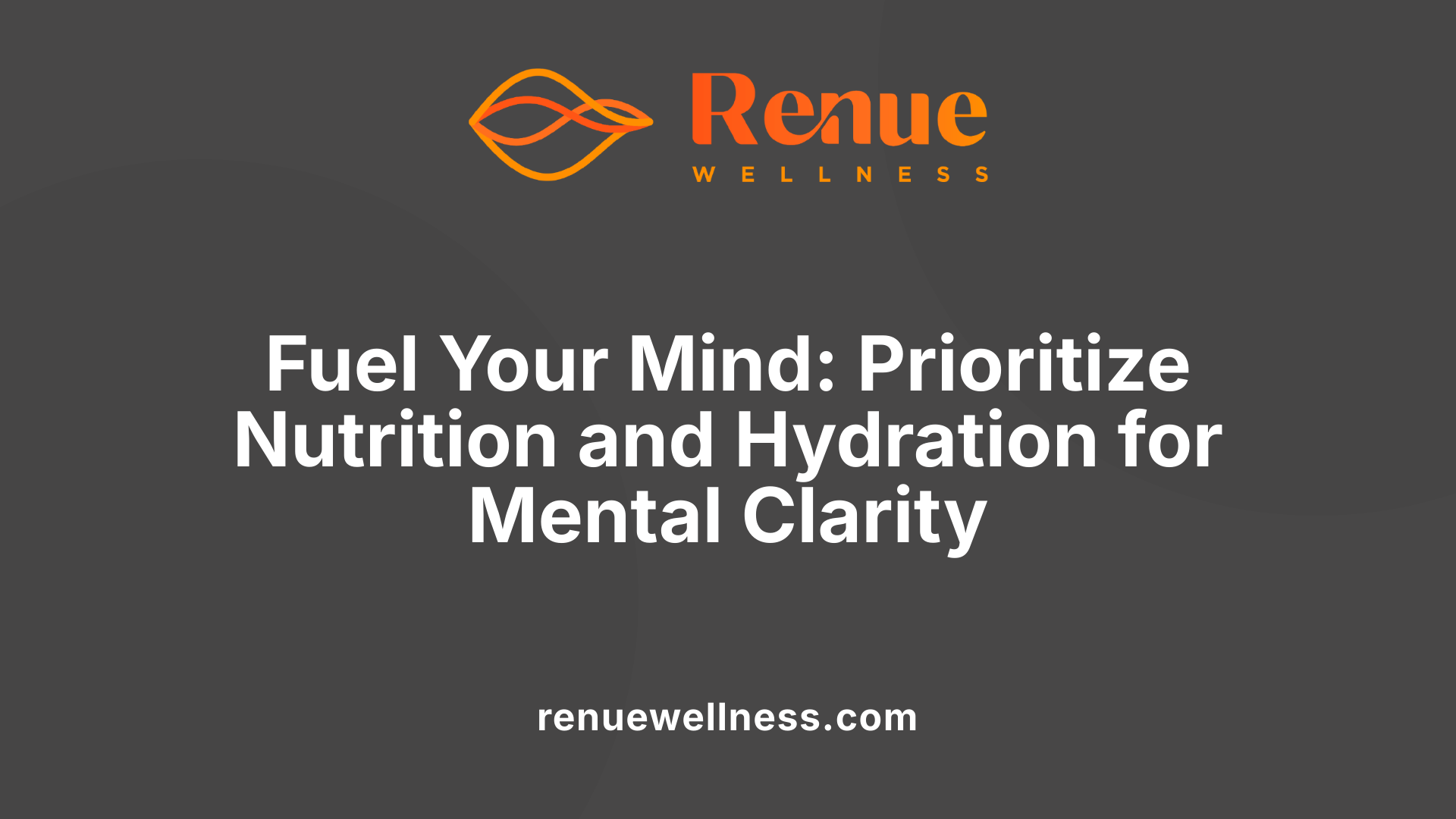
How does spring influence mental health through nutrition and outdoor activity?
Spring, a season of renewal, offers an excellent opportunity to boost mental well-being through proper nutrition and outdoor engagement. The longer daylight hours and milder weather encourage spending more time outside, which can naturally enhance mood and reduce symptoms of depression like seasonal affective disorder (SAD). Engaging in outdoor activities such as walking, gardening, and outdoor yoga not only increases physical activity but also promotes mindfulness and reduces stress.
What foods support mental clarity during spring?
Eating seasonal, nutrient-rich foods is vital for mental health. Leafy greens like spinach and kale, berries, and citrus fruits provide essential vitamins, antioxidants, and fiber that support brain function and emotional stability. Incorporating locally grown produce helps ensure freshness and nutrient density, making dietary choices more impactful.
How does reducing processed foods and sugar benefit mental well-being?
Reducing intake of processed foods and added sugars helps stabilize blood sugar levels, which in turn prevents mood swings, irritability, and fatigue. Cutting back on these less nutritious options supports sustained energy and emotional balance, allowing individuals to better manage stress and improve overall mental clarity.
Why is hydration important for mental health?
Staying well-hydrated is a simple yet powerful way to maintain cognitive function and emotional balance. Dehydration can lead to difficulty concentrating, fatigue, and irritability. Making a habit of drinking enough water throughout the day, especially during active outdoor spring activities, ensures the brain functions optimally.
| Aspect | Recommendation | Purpose |
|---|---|---|
| Seasonal foods | Include leafy greens, berries, citrus fruits | Support brain health and emotional stability |
| Limit processed foods | Reduce intake of fast food, snacks high in sugar and preservatives | Prevent mood swings and energy crashes |
| Hydration | Aim for at least 8 glasses of water daily | Enhance cognitive clarity and emotional regulation |
How can organizations and individuals plan effectively?
Resources like the National Alliance on Mental Illness (NAMI) and the Substance Abuse and Mental Health Services Administration (SAMHSA) offer guidelines and support frameworks to develop wellness initiatives. Evidence-Based Practices (EBPs) integrate strategies such as nutrition, movement, and social connectivity to foster mental health.
| Resource | Focus Area | How It Supports Mental Wellness |
|---|---|---|
| NAMI | Education, Support, Advocacy | Provides community programs and resources |
| SAMHSA | Prevention, Treatment | Promotes comprehensive mental health services |
| Evidence-Based Practices | Mindfulness, Movement, Nutrition | Guides structured wellness efforts |
| Digital Helplines | Crisis intervention | Offers immediate support in emergencies |
Spring’s combination of natural beauty and fresh nutrition makes it an ideal season to refresh mental health routines. Embracing outdoor activities, choosing seasonal foods, and maintaining proper hydration can create a foundation for emotional resilience and mental clarity that lasts beyond the season.
The Role of Treatment Plans and Organizational Support in Mental Well-being
How can I develop a comprehensive mental wellness plan?
Creating a well-rounded mental wellness plan involves several important components. Start with a self-assessment to understand your sources of stress, emotional triggers, and current coping strategies. This introspection helps in pinpointing the areas that need support or change.
Incorporate daily self-care activities such as regular physical activity, balanced nutrition, sufficient sleep, and relaxation techniques like mindfulness or meditation. Setting achievable goals using SMART criteria—Specific, Measurable, Achievable, Relevant, and Time-bound—can guide your progress.
Building a support network by nurturing relationships and seeking social engagement also boosts mental resilience. Learning new skills, practicing gratitude, and contributing to community activities foster a sense of purpose and belonging.
To maintain focus and track progress, consider creating a personalized Wellness Action Plan (WAP). This document outlines your strategies for managing stress, signals early warning signs of mental health issues, and suggests workplace or lifestyle adjustments. Regularly reviewing and updating your plan ensures it remains relevant as your circumstances evolve.
When symptoms are persistent or severe, don’t hesitate to seek professional assistance. Healthcare providers and mental health specialists can offer guidance tailored to your needs. Utilize crisis resources whenever necessary to ensure safety.
What organizational programs support mental health?
Workplaces can play a significant role in fostering mental well-being. Initiatives like the Nurse Well-Being: Building Peer and Leadership Support program by the American Nurses Foundation exemplify this effort. Launched with substantial funding, it aims to reduce burnout and equip nurses with tools to manage stress, resulting in a reported 28% decrease in burnout rates.
Similarly, mental health days are becoming a common policy tool. By offering designated days off dedicated to mental health, employers promote rest and emotional recharge, which can improve overall productivity, reduce absenteeism, and foster a healthier work culture.
Implementing these programs involves steps like evaluating current workplace conditions, obtaining necessary approvals, educating managers and staff, and monitoring outcomes. Enhancing these initiatives with flexible scheduling, manager training, and wellness activities aligns with broader efforts to support mental health.
Supporting organizational culture with programs like these is crucial, particularly in the wake of increased awareness about mental health challenges during the pandemic era. Encouraging open communication, reducing stigma, and providing ongoing support contribute to a sustainable environment where mental wellness is prioritized.
Implementing Mental Health Days and Flexible Workplace Policies
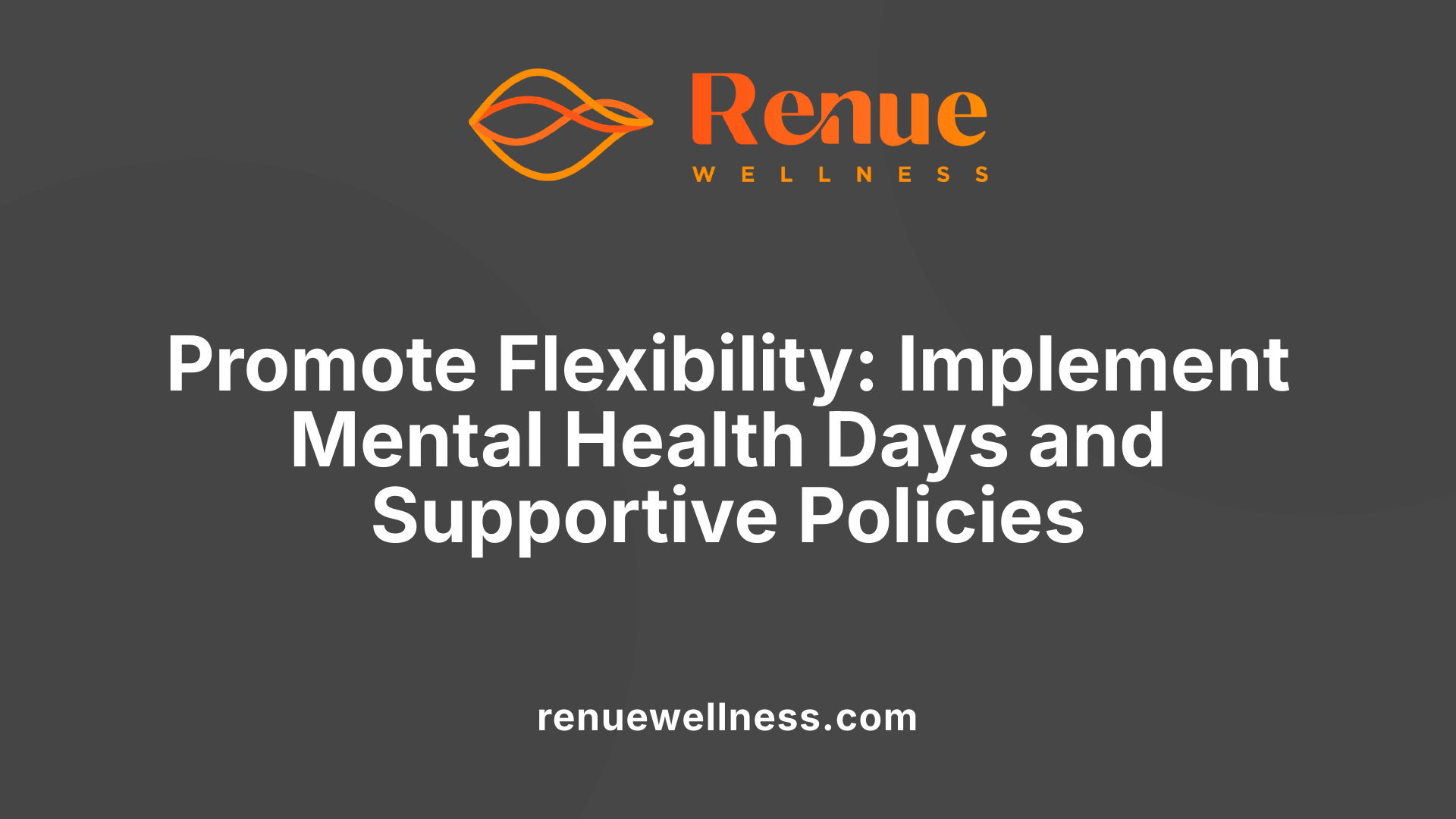
How can organizations design effective mental health day policies?
Developing a mental health day policy begins with clearly defining the purpose and scope. Employers should decide whether days are scheduled or floating, ensuring flexibility to accommodate different employee needs. Involving employees in the policy design process can promote buy-in and ensure the policy addresses real concerns.
Once established, organizations need management and legal approval to ensure compliance with labor laws and nondiscrimination standards. Clear communication about the policy's details, eligibility, and procedures is essential.
Providing training for managers on recognizing signs of burnout and how to support employees requesting mental health days fosters a supportive environment. Monitoring the policy’s impact and making adjustments based on feedback helps maintain its effectiveness and fairness.
What are the benefits for both employers and employees?
Offering mental health days can significantly improve workplace well-being. For employees, these days provide needed time to rest, de-stress, and manage mental health challenges, which can reduce burnout and improve overall morale.
Employers benefit through higher productivity, lower absenteeism, and enhanced retention rates. When employees feel supported, the organizational culture becomes more positive, encouraging open dialogue about mental health.
Furthermore, mental health days can reduce healthcare costs by preventing more severe issues that require extensive treatment.
How can flexible scheduling support mental health?
Flexibility in work schedules allows employees to manage their mental health proactively. Options such as adjustable start and end times, telecommuting, or compressed work weeks help employees balance work and personal life.
Organizations can implement wellness programs that include mental health support like counseling, meditation classes, and mental health apps. Combining flexible scheduling with these resources creates a comprehensive strategy to promote mental wellness.
Supporting a culture that values well-being encourages employees to prioritize their mental health without fear of stigma or repercussion.
| Aspect | Description | Additional Details |
|---|---|---|
| Policy Design | Clear, flexible, inclusive, and communicated effectively | Involve employees, legal review, management support |
| Employer Benefits | Increased productivity, retention, culture improvement | Cost savings, reduced absenteeism |
| Employee Support Strategies | Flexible scheduling, mental health days, wellness programs | Use of apps, counseling, training |
| Implementation Challenges | Gaining management buy-in, ensuring fairness, policy clarity | Continuous feedback, policy updates |
Creating an environment that actively supports mental health requires thoughtful policy-making and ongoing commitment. Organizations that invest in flexible work arrangements and mental health days help foster a resilient, engaged, and happy workforce.
Utilizing Technology and Digital Resources for Mental Health Support
What resources or frameworks can assist in planning mental wellness initiatives in personal or organizational contexts?
Effective planning of mental wellness programs often relies on a range of resources and structured frameworks. Organizations such as the National Alliance on Mental Illness (NAMI) offer a wealth of support programs, educational resources, and advocacy efforts that serve as foundational elements for personal or organizational initiatives.
The Substance Abuse and Mental Health Services Administration (SAMHSA) provides critical guidance with its focus on prevention, treatment, and recovery services, helping tailor initiatives to community needs.
Evidence-Based Practices (EBPs) are essential frameworks emphasizing approaches like mindfulness, physical activity, nutrition, and social engagement. These guide the development of effective and sustainable wellness plans.
Research organizations such as the Global Wellness Institute produce reports, trend analyses, and strategic recommendations to inform planning, ensuring initiatives are aligned with current scientific understanding.
Digital platforms play a vital role in extending support. Helplines like the 988 Suicide & Crisis Lifeline offer immediate assistance, while websites such as FindTreatment.gov help users locate appropriate services.
For targeted support, specialized resources address the needs of different groups, including youth, veterans, rural populations, and educational institutions. These tools enable organizations to craft culturally sensitive and impactful mental health initiatives.
Implementing these resources within a structured framework ensures that mental health strategies are comprehensive, scalable, and capable of addressing diverse needs effectively.
Fostering a Supportive Organizational Culture and Education
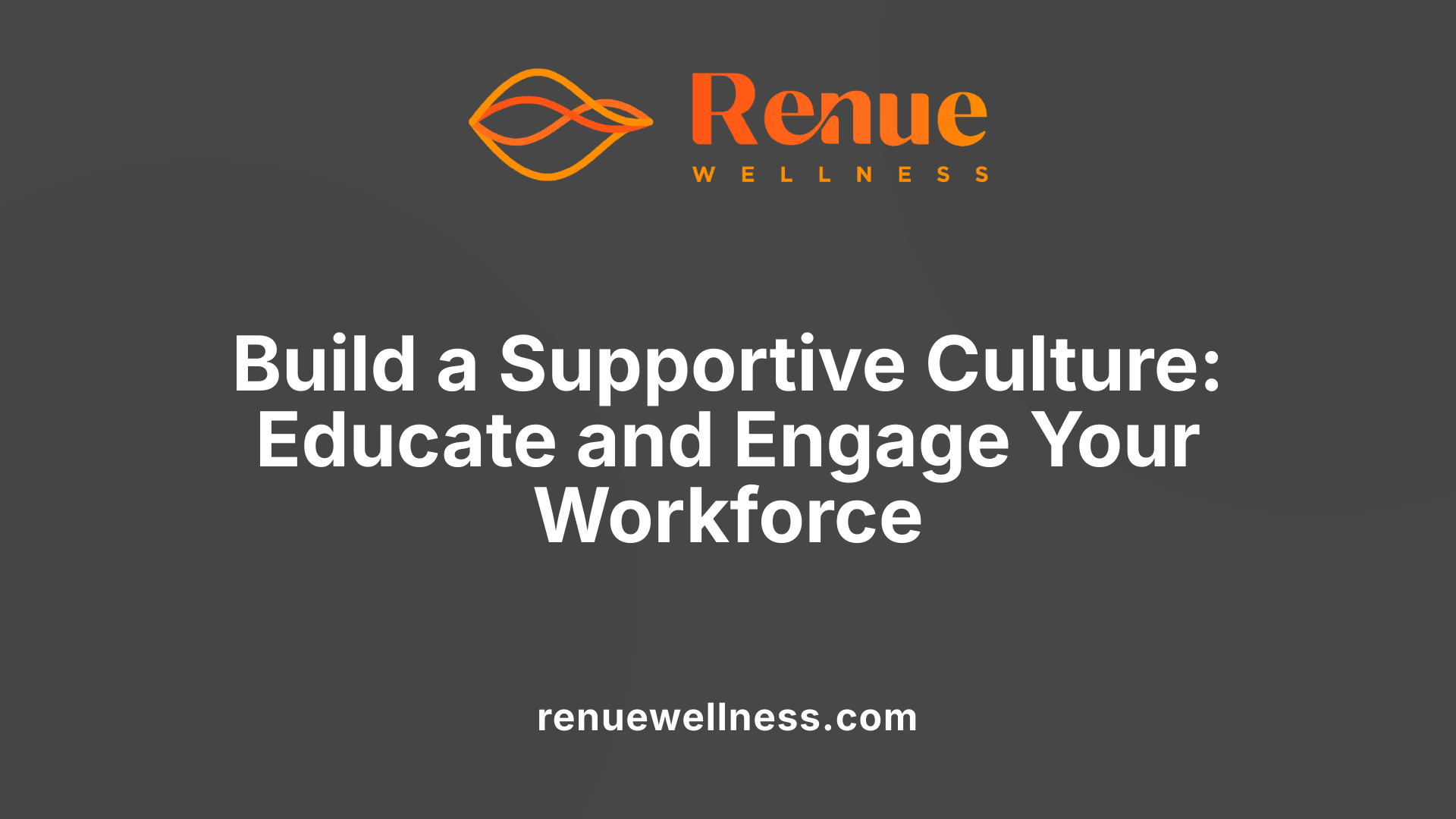
What is the role of leadership and managers in creating a mental health-friendly environment?
Leaders and managers play a crucial role in shaping organizational culture and promoting mental health awareness. By modeling open communication and demonstrating support for mental well-being, they set a tone that encourages employees to prioritize their emotional health. Effective managers actively recognize signs of stress and burnout, providing appropriate accommodations and fostering a safe space for employees to share concerns without fear of stigma.
They also advocate for policies such as flexible scheduling, mental health days, and wellness programs that support emotional resilience. When leadership shows genuine commitment, it helps break down stigma and creates an environment where mental health is integrated into overall organizational health.
How can training programs and ongoing education support mental health in the workplace?
Training programs aimed at managers and employees are essential for developing mental health literacy. These initiatives usually cover topics like recognizing mental health issues, supporting peers, and understanding available resources. Continued education ensures that staff stay informed about evolving best practices and tools for mental wellness.
Organizations like the American Nurses Foundation have introduced curricula such as 'Nurse Well-Being: Building Peer and Leadership Support,' which emphasizes skills like peer support, leadership in mental health, and managing stress. Training sessions often include scenario-based learning, role-playing, and workshops designed to normalize conversations around mental health and equip staff with practical intervention strategies.
How does breaking stigma and promoting openness aid in mental health recovery?
Reducing stigma is fundamental to encouraging individuals to seek help and participate in recovery. An open organizational culture that values transparency helps employees feel safe discussing mental health challenges without fear of judgment or negative repercussions. This openness fosters peer support, early intervention, and community building.
Programs that promote mental health awareness, share success stories, and provide education on mental health conditions contribute to normalizing these conversations. When mental health is approached with empathy and understanding, individuals are more likely to embrace treatment, access support services, and experience improved recovery outcomes.
Effective intervention strategies for mental health recovery
Supporting recovery involves various strategies tailored to individual needs. These include:
- Therapeutic options such as cognitive-behavioral therapy (CBT), psychotherapy, and group therapy, which help individuals process emotions and develop coping skills.
- Medication management ensures symptom control and stabilization, with medical oversight.
- Lifestyle modifications, including regular exercise, mindfulness exercises, good sleep hygiene, and a nutritious diet, bolster overall mental health.
- Digital tools like mental health apps and online therapy platforms expand access, especially in underserved areas.
- Early intervention and psychoeducation empower individuals to recognize symptoms and seek help promptly.
- Family involvement and community programs build support networks and foster resilience.
Addressing social determinants of health, overcoming barriers such as access disparities, and reducing stigma are vital to achieving successful outcomes.
Building Resilience and Maintaining Progress in Mental Wellness
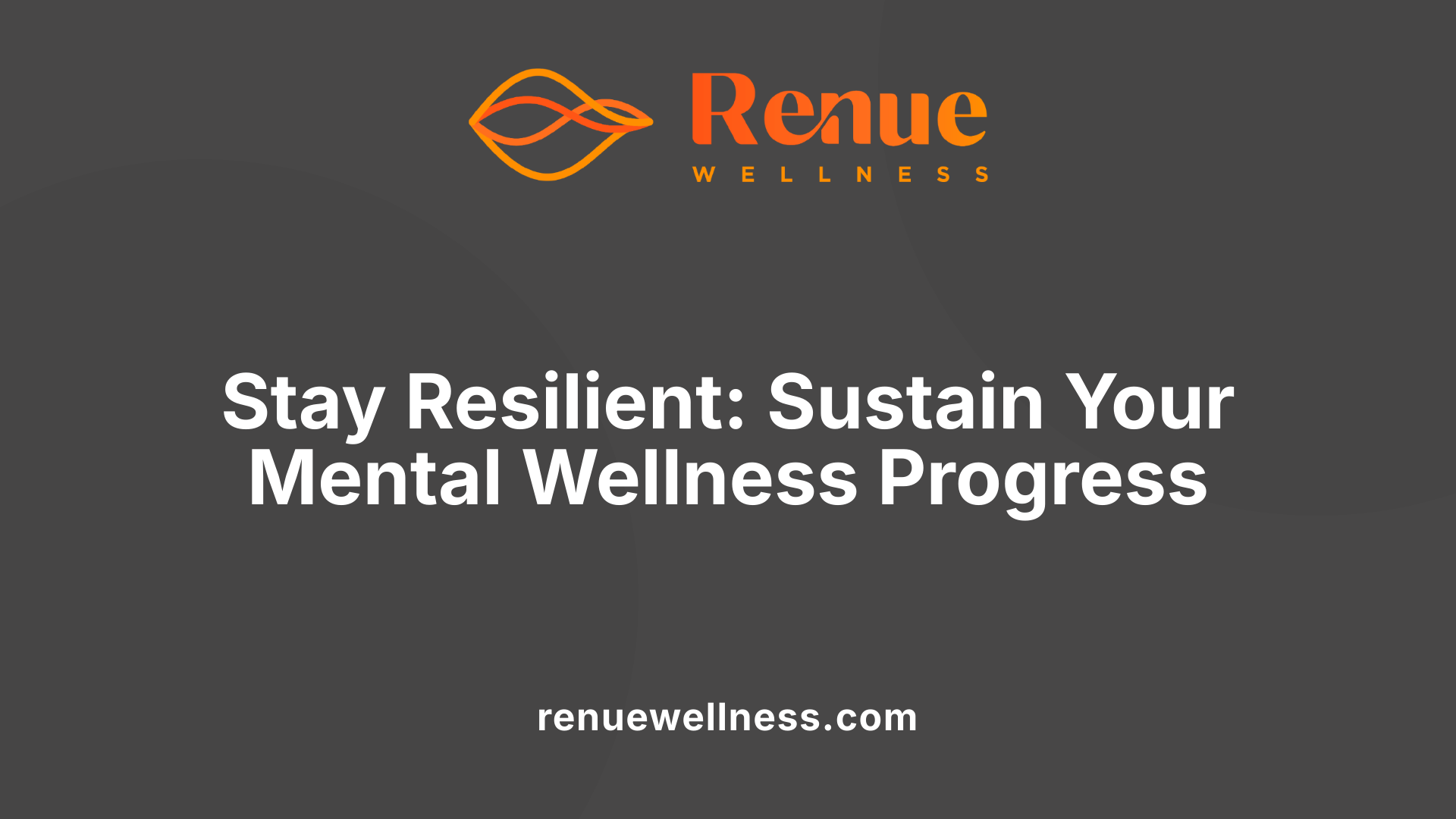
How can I develop a comprehensive mental wellness plan?
Creating a solid mental wellness plan begins with self-awareness. Start by conducting a self-assessment to identify your personal stress triggers, emotional responses, and current coping mechanisms. This helps you understand what influences your mental health and where adjustments are needed.
Incorporate daily self-care routines such as engaging in physical activity like walking or yoga, eating nutritious and seasonal foods, ensuring adequate sleep, and practicing relaxation methods like mindfulness or meditation. Setting achievable goals based on the SMART criteria—specific, measurable, attainable, relevant, and time-bound—can make your wellness journey manageable.
Strengthening your support network is essential. Spend quality time with friends and family, join community groups, or participate in outdoor activities which improve your sense of belonging and emotional balance. Developing new skills or hobbies can foster resilience and purpose.
A useful tool is the Wellness Action Plan (WAP). This personalized document outlines your coping strategies, warning signs of distress, and possible workplace or lifestyle adjustments. Regular review and updating of your WAP—every 3 to 6 months—are critical to adapting your plan to changing circumstances.
If symptoms persist or worsen, don't hesitate to seek professional help from healthcare providers or mental health specialists. Remember, crisis resources are available to support you during tough times.
Tracking your mental wellness progress is an ongoing journey. Monitoring improvements and setbacks can motivate you to stay committed, make informed choices, and celebrate milestones along the way, reinforcing your resilience.
| Step | Action | Purpose |
|---|---|---|
| Self-assessment | Identify stress sources and triggers | Understand personal needs and challenges |
| Regular self-care | Engage in exercise, nutrition, sleep, relaxation | Maintain baseline mental health |
| Goal setting | Use SMART criteria for achievable objectives | Track progress and keep motivated |
| Support networks | Build connections and community engagement | Enhance emotional well-being |
| Develop a WAP | Outline strategies, warning signs, and adjustments | Guide responses to mental health changes |
| Professional help | Seek if symptoms worsen or persist | Ensure appropriate treatment and support |
Through continuous effort, reflection, and adjustments, your mental wellness plan can serve as a resilient foundation for growth and fulfillment.
Embarking on Your Wellness Journey
Building a 6-month mental wellness plan with Renue is a dynamic, ongoing process that benefits from structured planning, supportive organizational policies, and personal engagement. By leveraging resources, embracing nature, fostering social connections, and utilizing innovative digital tools, individuals and organizations can create sustainable mental health strategies. The key is to review progress regularly, remain adaptable, and celebrate achievements along the way. With commitment and community support, a healthier, more resilient mind is within reach, especially during the season of renewal that spring offers.
References
- Spring Into Mental Wellness: Embracing the Season of Renewal
- Treatment Plan Templates, Examples & How to Write One - Mentalyc
- American Nurses Foundation Launches National Mental Health and ...
- How to Offer Mental Health Days at Work (An HR Guide) - Wellhub
- Employee Health and Wellness Programs - Cigna Healthcare
- 6 Steps of Mental Health App Development [with Features & Types]
- 6 Management Tips for Supporting Employee Wellbeing at Work
Recent Posts
Conditions Treated
AnxietyDepressionOCDPTSDPostpartum DepressionPain ManagementSubstance AbuseSuicidal IdeationOur Location


